My previous HO scale model railroad called the Piedras and Reddy River Railroad, modelled in various layout sizes and venues including a portable attempt.
Piedras and Reddy River is commissioned

The first Piedras & Reddy River layout was a 6×4 foot affair, which I quickly got annoyed with, as the track plan did not encourage good operating procedures! The plan I had based this layout on had a drill track for the yard, but I decided (for reasons unknown) to not include this feature. This meant that effectively I could only run one train at a time as a loco switching the yard would always foul the mainline! This layout lasted about a year, and then I scrapped it, keeping all the rollingstock, any usable track and buildings for the next layout.
Piedras and Reddy River – Mk II
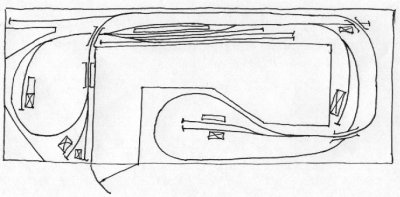
After this I purchased an old caravan which had no furniture in it, and built a layout in it which had a continuous run with some grades, a yard, some industries, and some reasonable scenery. The framework for this layout relied heavily on the structural integrity of the caravan, which I was to find out was a big mistake on my part! This layout was fun to operate as well, but I never finished the scenery as I discovered some structural problems with caravan the layout was in, and decided the best option was to scrap the layout and the caravan. Once again, though, I kept as much of the track and scenery that I could re-use, and the motive power and rollingstock.
The Piedras and Reddy River – Mk III
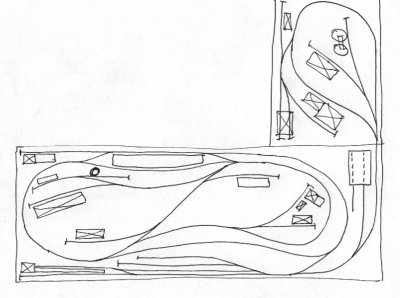
Piedras and Reddy River – Mk IV
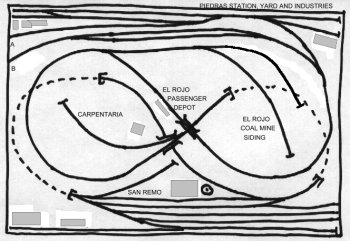
This next layout was “Portable” because the inside frame sat on top of my 6 x 4 foot trailer which then only had to get attached to my car and driven away. The frame was made out of the best pieces of the previous layout, and most of the track from the previous layout was re-used as the trackwork on that previous layout was mostly not ballasted. This layout was a point to loop (or out and back) plan, and had steep (5%) grades.
It had a decent size yard, and a number of industries, and was interesting to operate. It also had some good scenery, some of the mountains on it towering 120 or so scale feet (1 1/2 actual feet) above the bottom track level. Up till this point, this layout was the most complete layout I had ever built. But when we moved to a house that had a smaller area available for a layout this became a problem, so I opted to dismantle it and build another 6×4 foot layout, which would become the last Piedras and Reddy River RR layout.
The Piedras and Reddy River – Final Edition
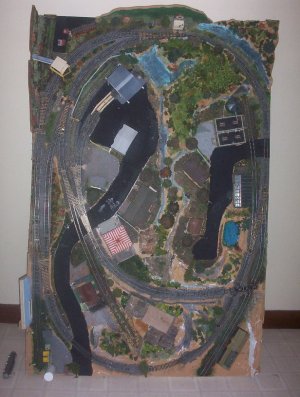
This 6×4 feet layout was based on a plan from the Gateway NMRA site. To see a track plan, you can go to www.gatewaynmra.org, then go to the Project Layouts section, then choose Project Layout IX (9) for more information. I added 2 other modules to the basic 6 x 4 foot layout. These extra 2 modules could be attached in varying configurations, depending on the space available.
This meant that I could have a layout which is only 6 x 4 feet, or if space permitted, a layout up to about 8 x 6 feet in area. With the extra modules attached, the mainline was almost doubled, allowing for longer trains, or shunting a train while another ran on the mainline. This layout also had scenery that went below the track level, and incorporated a double track timber trestle bridge. This layout was the first one of mine to have DCC used on it.
Delving into Digital
In a model shop in about 2005, I saw the Bachmann EZCommand DCC system packaged with a DCC equipped loco. I had been thinking of trying DCC, and felt that this was a good place to start, and so I purchased a Bachmann EZCommand DCC system and 1 Bachmann DCC equipped loco while I had the latest P&RR layout. I was suitably impressed with the flexibility of DCC and so I purchased another 3 Bachmann DCC equipped locos, which made operating the layout a whole lot more fun.
The Piedras and Reddy River becomes a Fallen Flag, but seeds the next layout – the C&SFT
Eventually I scrapped this latest P&RR RR layout and dropped the Piedras and Reddy River name as I felt I wanted a point to point / switching layout. I studied track plans in the 101 Track Plans for Model Railroaders and on the Internet, did some track plan diagrams and more or less settled on a variation of the Port Odgen and Northern RR shunting layout in the 101 plans book.
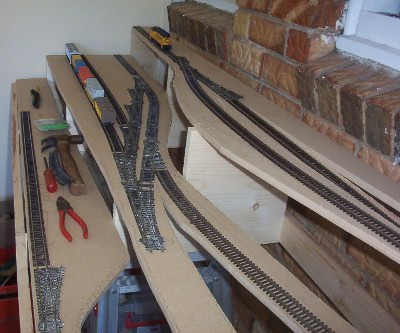
The variation was that it had to go around a wall in the spare bedroom and fit into a 10 x 7 foot space rather than being a longer straight layout. I kept as much of the buildings, turnouts, track, etc, for the new layout, which I eventually called the Chicago & South Forest Terminal RR (C&SFT). Along the way, I decided to change the layout from the multi-level switch back type of plan like the Port Odgen and Northern to a more flat layout, more representative of the northern Illinois area I had chosen to model.